Gloster Gladiator Mk.I

ICM, 1/32 scale
S
u m m a r y : |
Description and Item No.: |
ICM Kit No. 32040 - Gloster Gladiator Mk.I |
Contents and Media: |
123 parts in medium grey plastic; Ten parts in clear plastic (one marked not for use); one decal sheet covering four subjects |
Price: |
£43.99 EU Price (£36.66 Export Price) plus shipping available online from Hannants |
Scale: |
1/32 |
Review Type: |
First Look |
Advantages: |
Lovely surface textures including convincing stretched fabric effect as well as raised fasteners and fairings; separate control surfaces; high standard of moulding; engine detail included. |
Disadvantages: |
All plastic parts packed into a single bag; some simplified details. |
Recommendation: |
It is great to see ICM delivering this icon in the increasingly popular scale of 1/32. Detail is good, parts breakdown looks pretty straightforward and the model looks great in the box. Now the only remaining question is, how does it build?. |
Reviewed by Brett Green

G.W.H.s 1/144 Victor K.2 will be available online from Squadron.com
The Gloster Gladiator (or Gloster SS.37) was a British-built biplane fighter.
It was used by the Royal Air Force (RAF), the Fleet Air Arm (FAA) as the Sea Gladiator variant, and was exported to a number of other air forces during the late 1930s.
It was the RAF's last biplane fighter aircraft and was rendered obsolete by newer monoplane designs even as it was being introduced. Though often pitted against more formidable foes during the early days of the Second World War, it acquitted itself reasonably well in combat.
The Gladiator saw action in almost all theatres during the Second World War, with a large number of air forces, some of them on the Axis side.
The RAF used it in France, Norway, Greece, the defence of Malta, the Middle East, and the brief Anglo-Iraqi War (during which the Royal Iraqi Air Force was similarly equipped). Other countries deploying the Gladiator included China against Japan, beginning in 1938; Finland (along with Swedish volunteers) against the Soviet Union in the Winter War and the Continuation War; Sweden as a neutral non-combatant (although Swedish volunteers fought for Finland against USSR as stated above); and Norway, Belgium, and Greece resisting Axis invasion of their respective lands.
The South African pilot Marmaduke "Pat" Pattle was the top Gladiator ace with 15 victories with the type*.
* Historical text adapted from Wikipedia
This is the first mainstream Gloster Gladiator kit to be released in 1/32 scale.
ICM's 1/32 scale Gloster Gladiator Mk.I comprises 123 parts in medium grey plastic, ten parts in clear plastic (one marked not for use) and one decal sheet covering four subjects.
The kit is presented in ICM's usual satin-finished plastic. Moulding quality is very high. Some parts look like they have leapt straight from a CAD drawing into the box!
Surface textures look really good. The stretched fabric effect is convincing without trying too hard, while the raised fasteners and fairings are all perfectly appropriate.

Parts breakdown is conventional for a biplane with fuselage halves and two separate wing assemblies.
The cockpit is fairly basic but most of the key elements are here. You'll have to supply your own harness straps though.
Cockpit framing is supplied as one piece each side. The instrument panel features simple raised circles and a few switches. Indivdual decal dials are provided on the kit decal sheet. It's only a matter of time (and a short time, I'm sure) before we will have options for upgrading the cockpit from Eduard and others. The pilot's entry doors are separate parts and may be posed open if you wish.
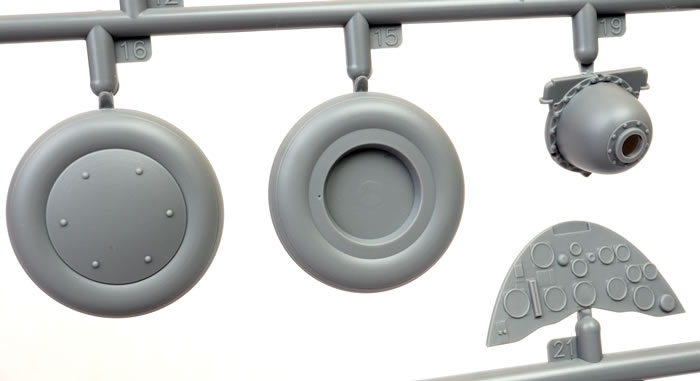
The lower wing is made up of a full-span bottom half and separate port and starboard upper parts. All control surfaces are separate parts and may be posed to taste with only minor surgery required (removing the locating tabs). The upper wing features full-span top and bottom halves.
In additon to the usual two cabane struts on the fuselage, there is just a single pair of interplane struts on each side. They are stout struts with deep locating recesses, so alignment and assembly should not be too daunting for first time biplane modellers.
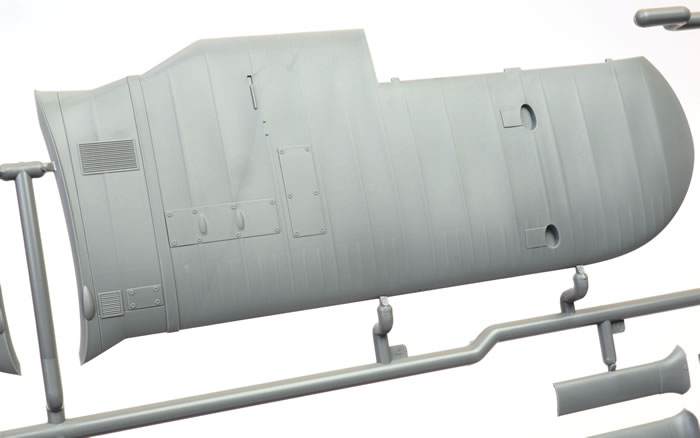
The engine looks pretty good. It is made up from 42 parts including the engine cowlings and propeller. Alternative styles of side cowls are supplied. An optional tropical air filter and spinner cap are also included.
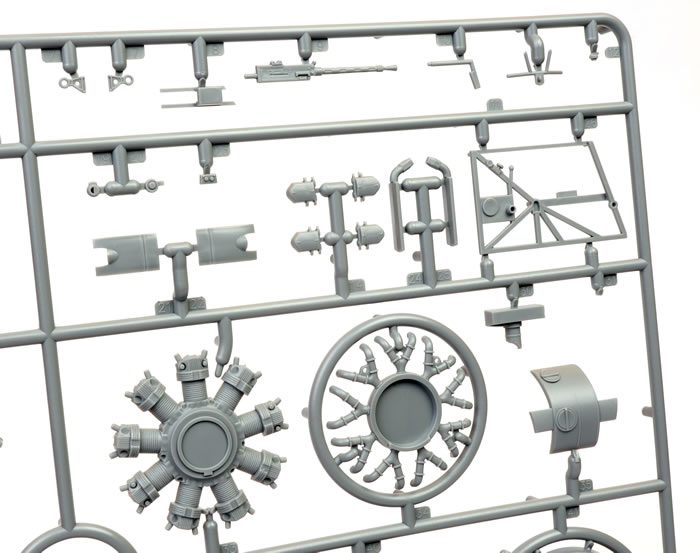
The clear parts are thin and free from distortion. The sections are separate so the sliding centre section may be posed open.
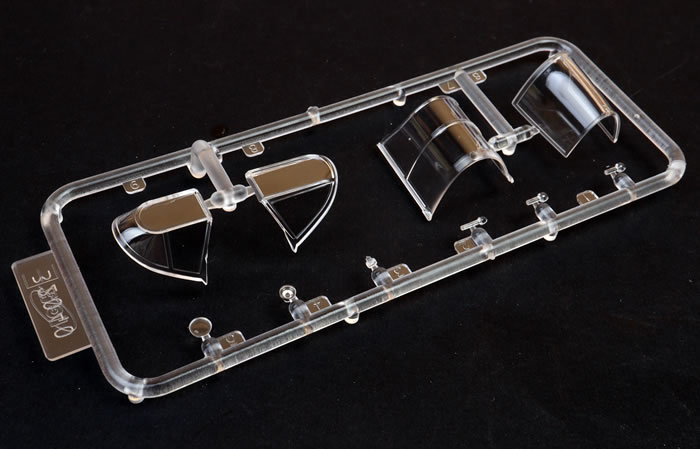
Rigging is called out over the final six steps of the instructions. Two different styles of aerial rigging are shown clearly in the instructions too.
Markings
The decals are in register and colours look good.
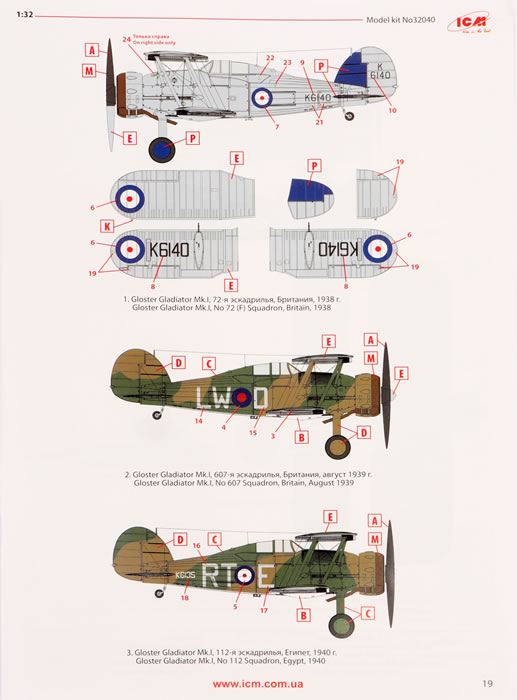
Most of the colours look fine. Please note that the pre-war blue is nowhere near as light on the decal sheet as it appears in the photo below. .
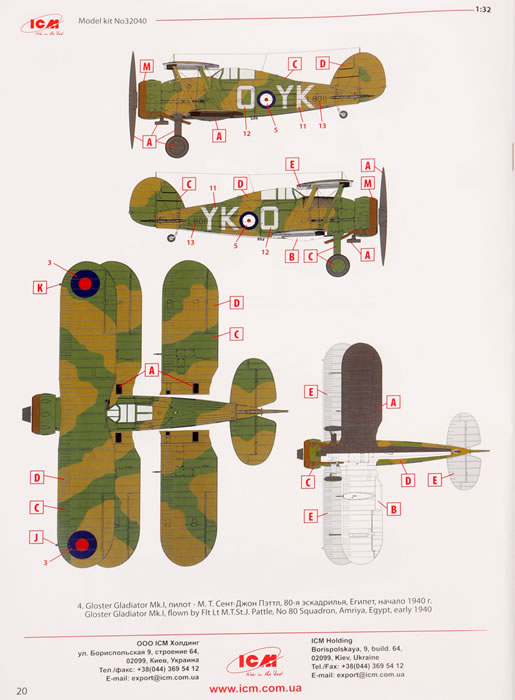
Markings are supplied for four options
-
Gloster Gladiator Mk.I, 72 (F) Sqn, Britain 1938. Finished in overall silver dope.
-
Gloster Gladiator Mk.I, 607 Sqn, Britain, August 1939. Finished in Silver / Black / White lower surfaces with Dark Earth and Dark Green upper surfaces.
-
Gloster Gladiator Mk.I, 112 Sqn, Egypt, 1940. Finished in Silver / Black / White lower surfaces with Dark Earth and Dark Green upper surfaces.
-
Gloster Gladiator Mk.I, 80 Sqn, Amriya, Egypt, early 1940. Finished in Silver / Black / White lower surfaces with Dark Earth and Dark Green upper surfaces.

Stencil markings are included on the main decal sheet.
It is great to see ICM delivering this icon in the increasingly popular scale of 1/32.
Detail is good, parts breakdown looks pretty straightforward and the model looks great in the box. Now the only remaining question is, how does it build?
Sample purchased by the reviewer from Hannants
Review Text and Images Copyright © 2020 by Brett Green
Page Created 6 February, 2020
Last updated
7 February, 2020
Back to HyperScale Main Page
Back to Reviews Page

|
Home
| What's New |
Features |
Gallery |
Reviews |
Reference |
Forum |
Search